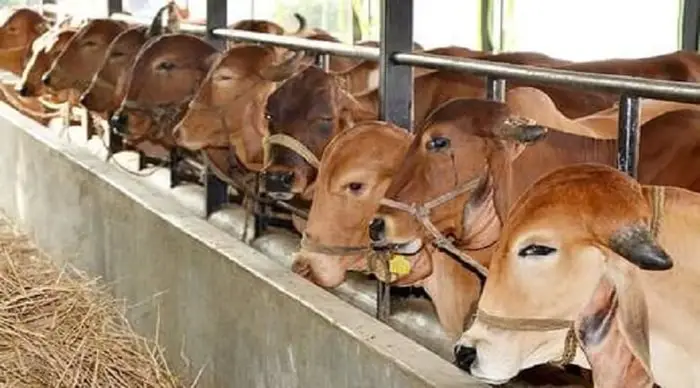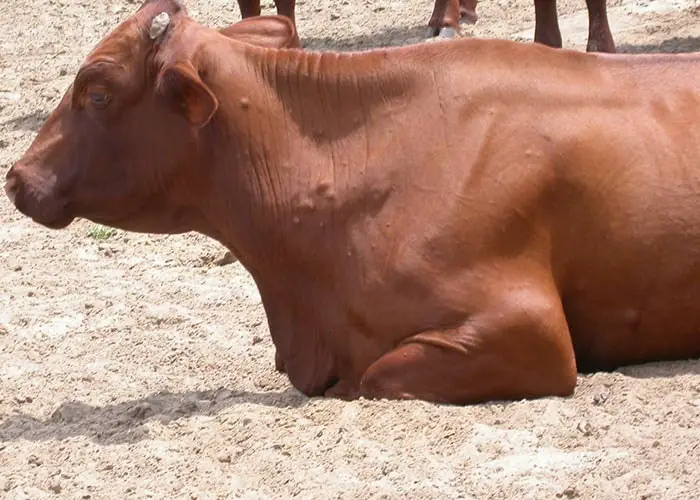Lumpy Skin Disease (LSD) is a deadly infectious disease of cattle and buffalo characterized by nodules in the skin and caused by a virus from the Poxviridae Capri pox virus. The disease is transmitted by direct contact, arthropods vectors, and by surgeons. LSD is one of the most spreading diseases recognized by the Organization International Epizootics (OIE). The disease was first diagnosed in Zambia in 1929. In the last 90 years, the disease spread in most African countries, the Middle East, and Asian countries. In 2015, the Lumpy Skin disease in cattle spread in mainland Europe; Greece, Bulgaria, Russia, and Balcan countries.
Importance of Lumpy Skin Disease
Lumpy Skin disease is one of the significant reasons for banning meat export in Europe and the United States of America. The Lumpy Skin Disease causes severe production loss the dairy and beef farm. The farmer will suffer heavy losses due to management and treatment costs. The disease will continue and readily spread to other healthy animals via multiple means. You must be very cautious and active in controlling and eradicating the disease from your farm. In my article, I shall highlight the major points of the disease for your easy understanding.

What Causes Lumps on the Skin?
The causal agent of Lumpy Skin Disease in cattle is the Capripoxvirus of Poxviridae. The other genus of the virus family is the Sheeppox virus and the Goatpox virus. The Capripox is a double standard DNA virus that is host-specific and distributes to some geographic regions. The primary host of the virus is cattle (Bos taurus and Bos indicus) and buffalo (Bubalus bubalis). In scientific research, it is found that the Holstein Friesian cross-breed cattle are more susceptible than healthy zebu cattle (Bos indicus). The morbidity is higher than the mortality.
Sources of LSD Virus
The Lumpy Skin disease is named as per the clinical signs; the affected animal’s skin becomes uneven or lumpy. The viruses found in higher amounts in the nodules, scabs, and lesions of the skin up to 35 days after infection. The Capripox virus also found in the saliva, blood, ocular and nasal discharge of the affected animals. The virus in the blood (viremia) found within 7-10 days after infection. The transmission of the virus through the seminal fluid is not established. The virus mainly causes acute disease and less tendency to chronic diseases.
Transmission of the LSD Virus
Lumpy skin disease is more prevalent in the hot and wet summer than in the winter. Low lying areas and blood-sucking insect prone areas are riskier for the spread of the Lumpy Skin Disease. The virus is transmitted by multiple means like arthropod vectors Mosquitos ( Anaphylaxis and Culex), biting flies, male ticks, direct contact with the affected animals, contaminated feed and water, and iatrogenically ( repeated use of needle and medical equipment). The infected bull can transmit the Capripoxvirus via breeding.
Clinical Signs of Lumpy Skin Disease
The morbidity rate of the Lumpy Skin Disease is higher, around 20-45%, and the mortality rate is not more than 10%. The incubation period of the disease is 4-14 days. The most prominent clinical manifestations of the disease are:
- High fever (temperature may rise 41 C)
- Swollen Lymph nodes.
- Enlargement of superficial lymph nodes.
- Development of large, firm nodules in the skin and diameter of the nodule up to 5 centimeters.
- The nodules may form in the whole body but mostly in the head, neck, dewlap, limbs, and perineum areas.
- The nodules become necrotic, painful, and discharge pus and fluids.
- Myiasis may be developed in crusted nodules.
- Vesicles, erosions, and necrotic ulcers may be developed in severe cases in the mouth, udder, and mucus membrane.
- Edema developed in the dewlap, limbs, brisket, and genitalia.
- Pregnant cows may abort and become anestrus for several months.
- Other non-specific signs are anorexia, dullness, conjunctivitis, rhinitis, and excessive salivation.
- The sudden decrease in milk production.
- After recovery of the disease, the affected animal becomes emaciated.
- The secondary disease may be developed like pneumonia, mastitis, and necrotic skin diseases.
Diagnosis of LSD
The diagnosis of LSD in cattle is mainly based on clinical history, signs, and laboratory confirmation by detection of the causal virus.
- Presence of nodules on the skin and mucous membrane.
- Formation of pus, crusted nodules, and myiasis may develop.
- History of the presence of blood-sucking arthropod vectors in the farmhouse.
- Laboratory diagnosis by PCR, ELISA, Western Blot, and virus neutralization test.
Differential Diagnosis of Lumpy Skin Disease
The disease is confused with many other similar diseases and similar clinical signs. The diseases similar to the Lumpy Skin diseases are:
- Pseudo-Lumpy Skid Disease caused by Bovine Herpes Virus-2.
- Cutaneous Tuberculosis caused by Mycobacterium tuberculosis.
- Bovine Papular Stomatitis causes by Parapoxvirus.
- Cowpox.
- Pseudocowpox caused by Parapoxvirus.
- Papipomatosis or Warts caused by Papillomavirus.
- Urticaria.
- Photosensitization.
- Demodicosis caused by Demodex mange.
- Insects or tick bites.
- Bovine Rinderpest.
- Hypoderma Bovis infection.
- Besnoitiosis.
- Dermatophilosis.
How Do You Treat Lumpy Skin Disease in Cattle?
There is no specific treatment available for Lumpy Skin disease. You must isolate the affected animal from a healthy one. Supportive treatment and management should be provided for consulting with your vet. You can give antibiotics in case of secondary bacterial infection. Antihistamines and NSAID reduce the pain and itching in the affected area.

Prevention and Control
The disease’s prevention and control are mainly based on the rapid diagnosis and isolation of affected animals. The significant preventive measures for the disease are:
- Vaccination with live modified LSD vaccine by Neethling strain.
- You can also use Sheeppox and Goatpox virus vaccine.
- Natural immunity developed from the recovered animals.
- Control the arthropod vectors in the farmhouse and pasture.
- Improve hygiene and sanitation in the cattle yard.
- Regular monitoring and diagnosis of the disease.
- Isolation and culling of severely affected animals.
Concluding Remarks on Lumpy Skin Disease
Lumpy Skin disease is one of the most devastating and deadly diseases of cattle and buffalo. The disease has spread widely throughout the world and has significant economic importance for both the beef and dairy industry. As a farm owner, the LSD is a very notorious disease that will cause massive economic loss. In the above discussion, I have tried to accumulate all related information of Lumpy Skin Disease in cattle for your easy understanding. If the above information benefits you, please share it with others through social media.